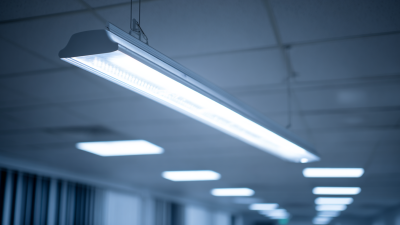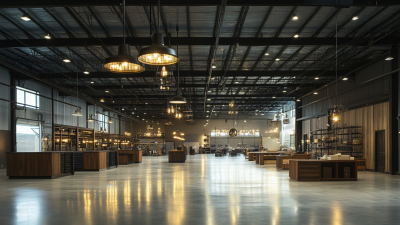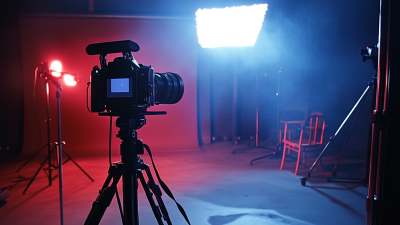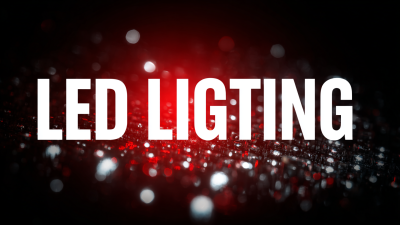How to Maximize Energy Efficiency with LED Factory Lighting Solutions
In today's industrial landscape, maximizing energy efficiency has become imperative for manufacturing facilities, with LED factory lighting emerging as a pivotal solution. According to the U.S. Department of Energy, LED lighting can reduce energy consumption by up to 75% compared to traditional incandescent bulbs, while also lasting 25 times longer. This shift not only lowers operational costs but also significantly reduces greenhouse gas emissions, aligning with sustainability goals that many companies are now prioritizing. Furthermore, a recent study by Navigant Research indicates that the global market for LED industrial lighting is expected to reach $8.9 billion by 2024, underscoring the growing recognition of LED technology as a viable option for enhancing productivity and efficiency within factory environments. By implementing LED factory lighting, businesses can capitalize on these advantages, creating a brighter, more efficient workspace while contributing to environmental stewardship.

Understanding the Basics of LED Technology and Its Benefits for Factories
LED technology has revolutionized factory lighting by offering numerous benefits that enhance energy efficiency. At its core, LED, or Light Emitting Diode, technology uses a semiconductor to convert electricity directly into light, which results in significantly lower energy consumption compared to traditional lighting solutions. Factories can reduce their electricity bills substantially by switching to LED lights, as they consume up to 75% less energy than incandescent bulbs and can last up to 25 times longer.
In addition to energy savings, LED lighting provides better quality illumination, which is essential for factory environments. LEDs emit light in a specific direction, minimizing wasted light and enhancing visibility on production lines. Furthermore, they are available in various color temperatures, allowing facilities to select the optimal lighting for specific tasks, thereby improving worker productivity and safety. The durability and low heat emissions of LEDs also minimize maintenance needs, contributing to a more sustainable and cost-effective lighting solution over time.
Maximizing Energy Efficiency with LED Factory Lighting Solutions
This bar chart illustrates the energy consumption comparison between traditional lighting solutions and LED lighting solutions in factories. The data showcases the energy savings achieved by switching to LED technology.
Evaluating Your Current Lighting Setup: Identifying Inefficiencies
Evaluating your current lighting setup is crucial in identifying inefficiencies that can significantly impact energy consumption and operational costs. Start by conducting an audit of your existing lighting system, taking note of the types of bulbs in use, lumens per watt, and the overall uniformity of light distribution. Look for areas that may be over-lit or under-lit, as these imbalances can lead to excessive energy waste. Gathering data on energy usage during different operational hours can also reveal patterns that pinpoint opportunities for improvement.

Incorporating LED lighting solutions can address these inefficiencies effectively. LEDs are known for their superior energy efficiency compared to traditional lighting methods, contributing to sustained energy savings over time. By utilizing smart controls and sensors, such as occupancy and daylight harvesting systems, facilities can further optimize lighting based on real-time needs. This not only enhances workplace comfort but also aligns with broader sustainability initiatives within industrial operations.
Adopting a systematic approach to evaluating and upgrading lighting configurations can lead to substantial improvements in energy performance while also fostering a more productive working environment.
Choosing the Right LED Lighting Solutions for Different Factory Areas
When selecting LED lighting solutions for various areas within a factory, it's essential to consider the specific needs of each space. For instance, production areas often require high-intensity lighting to ensure precision and safety. In these zones, LEDs with a higher lumen output can provide bright and uniform illumination, reducing shadows and enhancing visibility for workers. Additionally, selecting fixtures that are resistant to dust and moisture can prolong the lifespan of lighting in these industrial environments.

In contrast, offices and break rooms may benefit from softer, more ambient lighting. Here, warm white LEDs can create a comfortable atmosphere that promotes productivity and well-being. Adjustable lighting solutions with dimming capabilities can also be advantageous, allowing employees to tailor the brightness to their tasks throughout the day. Furthermore, implementing occupancy sensors in less-trafficked areas, such as storage rooms, can maximize energy savings by ensuring lights are only active when required. This tailored approach to LED lighting not only improves energy efficiency but also enhances the overall working conditions within the factory.
Implementing Smart Controls and Automation for Enhanced Energy Savings
Implementing smart controls and automation in LED factory lighting can significantly enhance energy efficiency. By integrating lighting systems with smart sensors, factories can automatically adjust lighting levels based on occupancy and natural light availability. For example, motion sensors can turn lights off in unoccupied areas and dim lights in response to incoming daylight, reducing energy consumption without sacrificing visibility. This not only saves electricity but also extends the lifespan of the lighting fixtures, resulting in lower maintenance costs.
Additionally, the application of centralized control systems allows for remote management and real-time monitoring of lighting performance. Factory managers can analyze usage patterns and identify opportunities for further optimization. Smart systems can be programmed with schedules that match operational hours, ensuring lights are only on when needed. Furthermore, integrating these systems with overall building energy management strategies can lead to holistic energy savings, improving the factory's sustainability profile while providing a better working environment for employees.
Regular Maintenance Practices to Ensure Long-Term Energy Efficiency of LED Lighting
Regular maintenance practices are essential for ensuring the long-term energy efficiency of LED lighting solutions in factories. According to a report by the U.S. Department of Energy, properly maintained LED lights can last up to 50,000 hours, significantly reducing the need for replacements compared to traditional lighting systems. However, even the most efficient systems can suffer from decreased performance if overlooked. Cleaning fixtures regularly can improve light output by up to 20%, which directly maximizes energy savings over time.
In addition to cleaning, regularly checking and updating lighting controls plays a vital role in energy efficiency. A study conducted by the Illuminating Engineering Society found that facilities implementing smart lighting controls—such as occupancy sensors—could achieve energy savings of 30-50%. Furthermore, regularly inspecting wiring and connections can prevent issues that might lead to increased energy consumption, ensuring that LED systems operate at their peak efficiency for years to come.
Adopting these maintenance practices not only optimizes performance but also extends the lifespan of LED fixtures, making them a sustainable choice for industrial lighting needs.
Related Posts
-

Exploring the Advantages of Led Lighting in Energy Efficiency and Cost Savings for Modern Businesses
-

Mastering LED Lighting Techniques for Energy Efficiency in Your Home
-

Ultimate Guide to Choosing the Best Lighting Fixtures for Your Business Needs
-

The Ultimate Guide to Finding the Best Quality Lighting Solutions for Global Buyers
-

How to Choose the Best LED Lighting for Your Home or Office Needs
-

Ultimate Guide to Selecting the Best LED Lighting Solutions for Global Buyers

